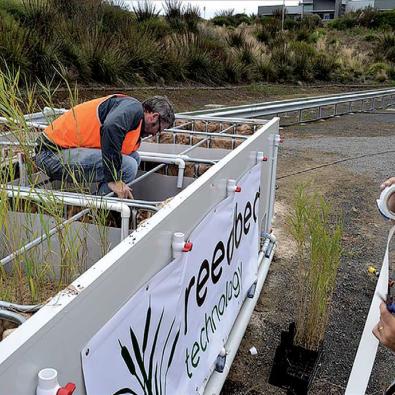The Tarago Water Treatment Plant has been trialling reed bed technology to reduce the volume of treatment sludge sent to landfill. Read this case study to learn more.
Sustainable Development Goals:
Goal 6: Clean water and sanitation
Goal 9: Industry, innovation and infrastructure
Goal 11: Sustainable cities and communities
Background
The Tarago Water Treatment Plant treats around 70 million litres of water per day from the Tarago Reservoir, with the process resulting in a large volume of waste sludge. Further treatment is then needed to reduce the amount of sludge and turn some of it into dried solids, which are then sent to landfill.
This currently uses a sludge thickening process and centrifuges, resulting in a sludge comprising 17 to 20 per cent dried solids.
Research focus
Reed bed sludge treatment was developed to treat both drinking water and wastewater treatment sludge. Reed beds are planted in a drying plan into which sludge is deposited, draining through the bed. The reeds’ roots and movement enhance sludge thickening, and being a natural home for microbes, also treat the sludge through biological activity.
For our trial at Tarago, we were keen to know if this reed bed technology would not only improve the sludge treatment process but also minimise operational costs, be more environmentally friendly and use less energy than the existing sludge drying system.
The pilot plant consisted of ten reed beds, each with an area of one square metre. One reed bed at a time was filled with unthickened sludge and allowed to ‘rest’, with the sludge drying through evaporation as well as by reed transpiration.
At the end of the trial the dried sludge was harvested and achieved a dried solids content of 30 to 50 per cent: roughly double the amount achieved by the current process.
Outcomes
These results suggest that if the full-scale reed bed system were to be implemented at Tarago, the sludge volume sent to landfill could be reduced by 73 per cent and electricity consumption potentially reduced by 16MWh per annum.
The Tarago trial also demonstrated the ability of reed beds to produce a much better quality treated water (filtrate) – better than that produced by the centrifuges, and in most cases as good as, or better than, the water recycled from the sludge thickener. The removal of contaminants such as suspended solids, nutrients, pathogens, algae and metal coagulants also occurred at higher rates.
This suggests that the reed bed filtrate could be readily returned to the water treatment process stream with a lower probability of issues caused by the recirculation of problem contaminants.
Based on the success of this trial, Melbourne Water is considering using reed bed treatment to treat up to 50 per cent of the sludge produced at the Tarago Water Treatment Plant.
You may also like...
Delivering on the Sustainable Development Goals
This report outlines Melbourne Water's unwavering commitment to advancing sustainability through the United Nations Sustainable Development Goals (SDGs).




